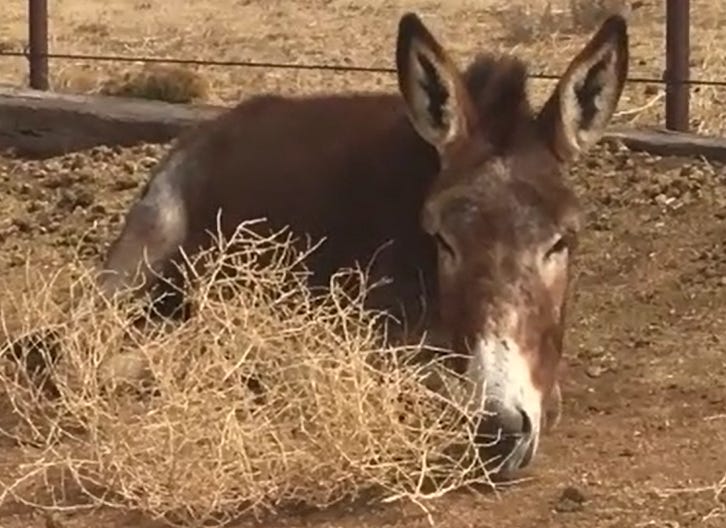Good morning! And thank you for joining me today.
It’s finally springtime in earnest. The mesquites are growing new leaves, and I spent an afternoon this week planting my small garden of peppers and cucumbers. The tender little plants seem so frail. I tied them to trellises to help them bear the wind and wrapped foil around the stems to deter cutworms. I hope they make it. My raised beds are filled with last year’s survivors, hardy plants which struggled through the winter, but are thriving now: kale, oregano, sage, mint, rosemary, and lavender.
The weeds are coming up with a vengeance, too: wild mustard, which seems to have arrived here this year in the wind. Locoweed and yuccas. A weird extravagance of sticker plants and buffalo burrs. And, of course, the ubiquitous tumbleweed. When I first moved to this house, and the yard was bare, tumbleweeds were the first green that appeared, and from a distance, the patches of them looked like soft carpets of grass.
Everyone knows what a dead tumbleweed looks like— that prickly golden ball of branches rolling across the highway. The Old West stereotype. We call every plant that rolls in the wind here a tumbleweed, whether round and bushy, or long and lean. Some are very prickly, some only slightly so. Russian thistles begin as tiny green stars on thin, white and red stems. They soon grow green and wide. They bloom with tiny flowers. Eventually, the plants break from their roots and travel from pasture to pasture, spreading their seeds to grow in any ground which has been disturbed. It is strange. One day, the tumbleweeds are growing where they have always been. The next, they’re gone, and I wonder: how did I miss their leaving?
My donkeys love tumbleweeds. They chase them as they roll by in the wind, catch them, carry them around, and finally eat them, crunching in satisfaction. They like leaving small ones in their water troughs for later, as if to soften them, or perhaps it’s the donkey version of a recipe.
I’ve read stories of how, during the Dust Bowl, some farm families had only tumbleweeds to feed to their livestock. I remember reading somewhere that some people in those times tried to can and eat tumbleweeds themselves. Knowing these things, I have to wonder: what would it be like for all my hope to rest on a tumbleweed? That’s what they make me think of most when I see them. And how hope can sometimes look like desperation.
A little hope goes a long way. What is miraculous is how little hope is needed to keep going. And how little it weighs. Yet, without it, living is just about impossible.
I think today’s poem is the only one I have ever written specifically about tumbleweeds, which are such an irrevocable part of the landscape here.
Tumbleweed Picking
The yard is lousy
with dark stars of them,
trails of them left where their predecessors traveled
the year before on their inexorable journeys
to ditches and barbed wire fences.
Most of those that came before
are flattened and burned by now,
but with the rains those tough shoots began
to push up the cracked ground,
lifting flat chunks of tan dirt in their miniature branches
while their red and white legs shook below.
They ruin the neighborhood for every other plant.
My salvia, strawberries, thyme have young tumbleweeds
nestling right in the centers of their beds.
They spread like oil stains over the land, in dark patches.
I pluck out whole forests of them--
the earlier the better, before they thicken and prick
the picker. Their young bodies, I leave
drying and blackening to show where I've been.
I have become obsessed with them,
see them on my eyelids like the ghosts of fireworks,
small sparkles and bursts.
I often go to bed with hands red
and swollen with brutality,
but no matter how many I rip
from the sand, more appear.
Strange to think that something which grows
with such tenacity
exists for the purpose of detaching,
rolling to the wind's whim.
When it rains, I watch the tiny plants I have pulled
washing down the rivulets,
each reaching with arms dried
and spiderlike, and one dried white taproot
trailing like regret.
If you’d like, please join me now for a moment of reflection. And please share your thoughts in the comments section for this post.
What is your favorite uncultivated plant, and why?
How do you keep hope alive when you’re struggling?
In other news, I’m participating in an event at the end of the month for the Praisesong for the People project, hosted by Texas Poet Laureate Amanda Johnston. If you happen to be close by, I’d love to see you!
I appreciate the time you’ve spent here with me today. I also want to remind you that it’s okay if you’re struggling right now. Please hold tight to what is good, and take good care of yourselves and each other.
I’ll see you next time.
*“Tumbleweed Picking” is included in the book The Traveler’s Guide to Bomb City, published by Purple Flag Press.
Do you need to take a break from these emails? You can unsubscribe in one click.









Great poem! Looking forward to the Praise Song for the People readings later this month. Sounds like a fun event.
"Strange to think that something which grows
with such tenacity
exists for the purpose of detaching,
rolling to the wind's whim."
This is excellent.
In The Worst Hard Time, Timothy Egan described the Russian-German immigrants who ended up in the High Plains in the 1800s. They sewed the seeds of red wheat into their vest pockets, intending to plant the wheat here. Which they did, and it thrived. But those collections included stray seeds that became invasive plants known as "perekati-pole" in their language, which translates into ”roll-across-the-field.” Russian Thistle.